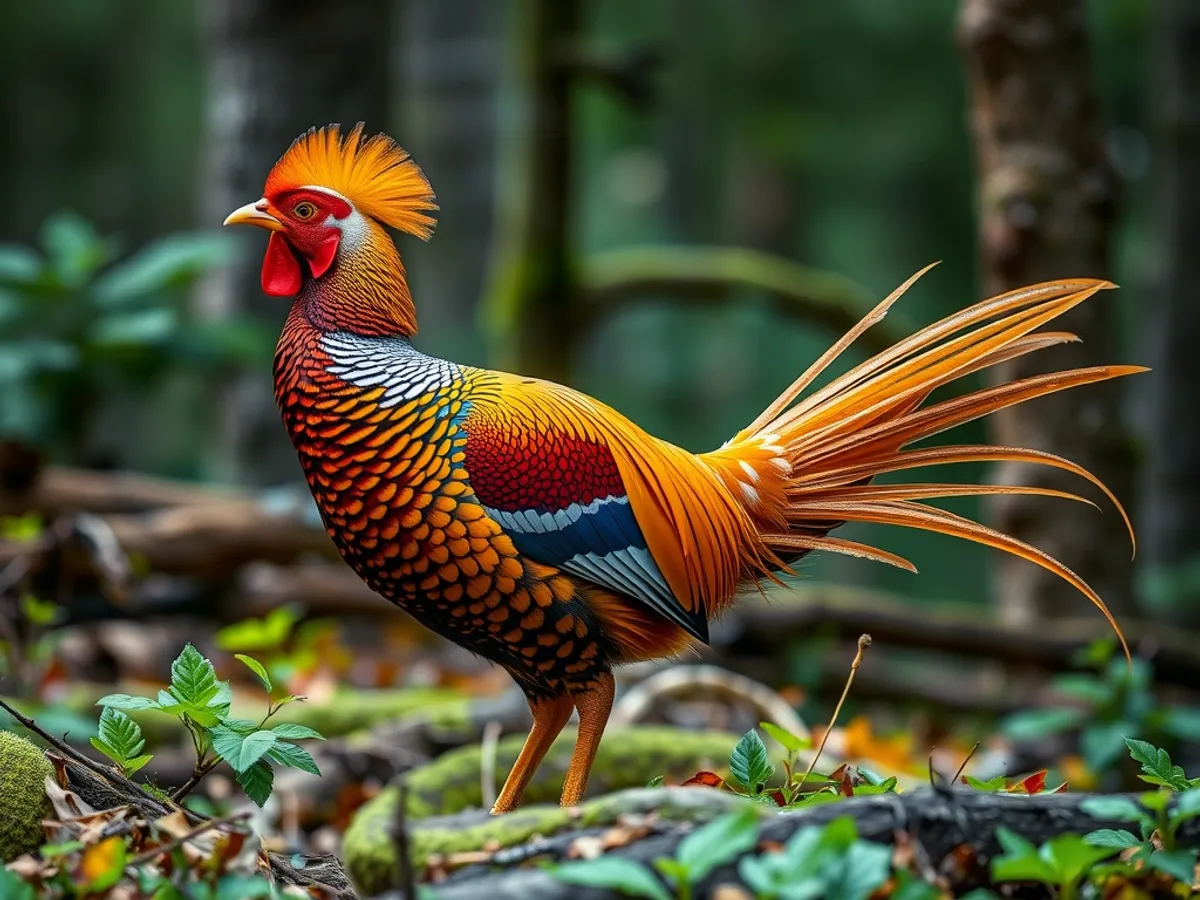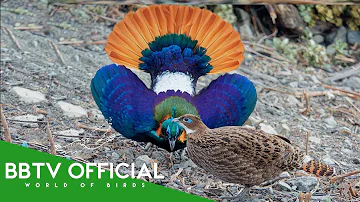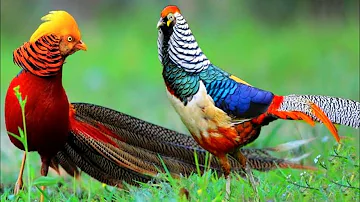
Golden Pheasant
Chrysolophus pictus

Meet the Golden Pheasant
The Golden Pheasant, also known as the Chinese Pheasant, is a strikingly colorful bird native to the forests and mountainous regions of western China. Males are renowned for their vibrant golden-yellow crests, deep red bodies, and a dazzling mix of orange, blue, and green plumage, while females are more subdued with mottled brown feathers for camouflage. These birds are ground-dwellers, foraging for food on the forest floor, but are capable of short, sudden flights when startled. Golden Pheasants are popular ornamental birds in aviaries worldwide due to their beauty and relatively docile nature.
Classification
Bird
Habitat
Mountain forests and dense woodlands
Diet
Omnivore
Lifespan
5-7 years
Conservation
Least Concern
Weight
550-700 grams
📖Fascinating Facts
Spectacular Males
Male golden pheasants are famous for their vivid golden crests and multi-colored plumage, which they use in elaborate courtship rituals.
Forest Dwellers
They inhabit dense, dark forests and woodlands, where their colors help them blend into the dappled sunlight and shadows.
Ground Nesters
Golden pheasants build simple nests on the ground, usually hidden beneath shrubs or dense vegetation to protect their eggs from predators.
📋Detailed Description
The Golden Pheasant (Chrysolophus pictus) is a medium-sized galliform bird, measuring approximately 90–105 cm (35–41 in) in total length, with the tail accounting for two-thirds of this length. Males are especially striking, displaying a golden-yellow crest that extends down the nape, a bright red underbody, and a mantle of iridescent orange, blue, and green feathers. The upper back is green, the rump and upper tail coverts are golden-yellow, and the long, barred tail is chestnut with black markings. Females are smaller (60–80 cm), with mottled brown plumage, providing effective camouflage in dense undergrowth. Both sexes have yellow eyes, pale bills, and legs. Golden Pheasants are primarily terrestrial, preferring to run rather than fly, but are capable of rapid, explosive flights when threatened. Their wings are rounded and relatively short, adapted for quick bursts rather than sustained flight. These birds are crepuscular, being most active at dawn and dusk, and are known for their secretive nature, often remaining hidden in thick vegetation. Their vocalizations are generally soft, consisting of whistles and clucks, but males produce distinctive metallic calls during the breeding season. The species is native to the mountainous forests and dense woodlands of western and central China, particularly in Sichuan, Shaanxi, and Tibet, but feral populations exist in the United Kingdom and other regions due to escapes from captivity.
💡 Did you know?
Golden Pheasants have been introduced into the wild in several countries, including the United Kingdom, where small feral populations have become established.
🔬Research & Sources
Wikipedia Summary
Golden Pheasant may refer to:Golden pheasant Golden Pheasant (beer) Golden Pheasant (horse), racehorse Golden Pheasant Award, the highest award given by the Scout Association of Japan Operation Golden Pheasant, 1988 U.S. military operation in Honduras against the Sandinistas
Last Modified: 8/28/2022
🎭Behavior & Social Structure
Golden Pheasants are ground-dwelling birds that spend most of their time foraging for food among leaf litter and low vegetation. Their diet is omnivorous, consisting of seeds, grains, berries, leaves, and invertebrates such as insects and spiders. They use their strong legs and feet to scratch the forest floor in search of food. Socially, they are generally solitary or found in small groups outside the breeding season, with males often being territorial. During the day, they alternate between periods of foraging and resting in dense cover. At night, they roost in trees to avoid ground predators. Males display elaborate courtship behaviors, including fanning their capes and tails, spreading their wings, and making sharp calls to attract females. Aggression between males can occur during the breeding season, often involving threat displays rather than direct combat.
👶Reproduction & Life Cycle
Golden Pheasants are polygynous, with males courting multiple females during the breeding season, which typically occurs from April to June in their native range. The male performs an elaborate display, raising his cape and tail, and circling the female while emitting a series of calls. After mating, the female selects a well-concealed nest site on the ground, usually under dense shrubbery or among tall grasses. She lays 5–12 pale buff eggs, which she incubates alone for 22–23 days. Chicks are precocial and leave the nest soon after hatching, following the mother and feeding independently within a few days. The female provides protection and guidance but does not feed the chicks directly. Fledging occurs at around 12–14 days, but young birds remain with the mother for several weeks.
🛡️Adaptations & Survival
Golden Pheasants possess several adaptations for survival in dense, mountainous forests. Their cryptic plumage in females and juveniles provides excellent camouflage against predators. The male's bright coloration is thought to play a role in sexual selection, signaling fitness to potential mates. Their strong legs and feet are adapted for scratching and digging in leaf litter, while their short, rounded wings allow for rapid, vertical takeoff to escape threats. Their keen eyesight helps them detect predators and locate food. Behavioral adaptations include crepuscular activity patterns to avoid peak predator activity and roosting in trees at night for safety.
📚Research Sources
🎨Cultural Significance
The Golden Pheasant holds significant cultural importance in China, where it is a symbol of beauty, prosperity, and good fortune. Its image appears in traditional Chinese art, textiles, and folklore, often associated with the mythical phoenix. The bird is also featured in imperial iconography and was historically kept in palace gardens. In Western culture, it is valued as an ornamental species in aviaries and private collections due to its striking appearance. The Golden Pheasant has inspired motifs in fashion and design, and its feathers have been used in ceremonial attire and fly-fishing lures.
🔬Recent Research & Discoveries
Recent studies have focused on the genetic diversity of wild and captive populations, revealing low genetic differentiation between native and introduced populations, suggesting frequent escapes and interbreeding. Research into the species' reproductive biology has provided insights into sexual selection and the evolution of ornamental traits. Conservation genetics studies are ongoing to assess the potential impacts of inbreeding in isolated populations. Behavioral ecology research has examined the role of habitat structure in nest site selection and predator avoidance. There is also interest in the species' adaptability to fragmented and human-modified landscapes, which may inform conservation strategies for other forest-dwelling galliforms.
🎥Wildlife Videos

30 Most Beautiful Creatures On Earth (Order Galliformes) | Wildlife Documentary | BBTV Official
In the heart of the world's most remote forests and rugged highlands, where mist lingers over ancient trees and the wilderness ...
BBTV Official

CGTN Nature: Qinling Mountains Series | Episode 3: Phoenix in the Mountain
Sporting an iridescent plumage, the golden pheasant is considered to be the prototype of the mythical phoenix in China's ...
CGTN

Golden Pheasant: A Flash of Gold in the Wild
Enter the magical realm of the golden pheasant, a bird as colorful as the sun filtering through trees. Nature enthusiasts and ...
The Story of Animals

Golden Pheasant : the most beautiful and colorful bird | 4K video | Animal Documentary
Welcome to Animal Documentary, your ultimate destination for captivating animal documentaries and breathtaking wildlife ...
The Jurassic AI Animation

Beauty of Nature - Golden Pheasant
The beauty of Nature - Golden Pheasant Golden pheasant, also known as the rainbow pheasant, are exceptionally breathtaking ...
NexVay

Beautiful Birds Singing Golden Pheasants and Wading Wildlife Documentary - amazing
Birds and environment It's hard to find a person who doesn't like birds. Birds maintain the balance of the environment and provide ...
Jahir Vlog@
🌍Habitat Information
The Golden Pheasant typically inhabits Mountain forests and dense woodlands environments. Golden Pheasants have adapted to their environments with specialized features and behaviors.
Primary Habitat:
Mountain forests and dense woodlands
More detailed habitat information will be available soon.
🛡️Conservation Status
The Golden Pheasant is currently classified as Least Concern. Conservation efforts are crucial for preserving this species for future generations.
Common Threats:
- 🏠Habitat loss and fragmentation
- 🌡️Climate change impacts
- 🎯Hunting and poaching
- 🏭Human-wildlife conflict
⚠️Threats & Conservation Challenges
In their native range, Golden Pheasants face threats from habitat loss due to deforestation, agricultural expansion, and human encroachment. However, they are adaptable and can persist in secondary forests and plantations. Hunting for food and the pet trade has historically impacted local populations, but the species is currently classified as Least Concern by the IUCN due to its wide distribution and large, stable population. In some introduced areas, feral populations may face predation from non-native mammals and competition with native species. Ongoing monitoring is necessary to detect any emerging threats, particularly as habitat fragmentation increases.
🔬Scientific Classification
Scientific Name
Chrysolophus pictus
Classification Hierarchy
🔍 About Taxonomic Classification
Taxonomic classification is a hierarchical system used by scientists to classify and organize living organisms based on shared characteristics and evolutionary relationships.
The system moves from broad categories (Kingdom) to increasingly specific ones, with each animal's scientific name typically consisting of its Genus and species.
📝Community Notes
Share your observations and insights about the Golden Pheasant with our community of wildlife enthusiasts.
Join Our Community
Sign in to share your observations and connect with fellow wildlife enthusiasts.
Sign In to ContributeNo community notes yet
Be the first to share your observations about the Golden Pheasant!
Explore Golden Pheasant
Select a tab above to learn more about this amazing animal.
📸Photo Gallery
No photos available for this animal yet.
🌟Discover More Wildlife
Continue your journey of discovery with more fascinating animals from our database
